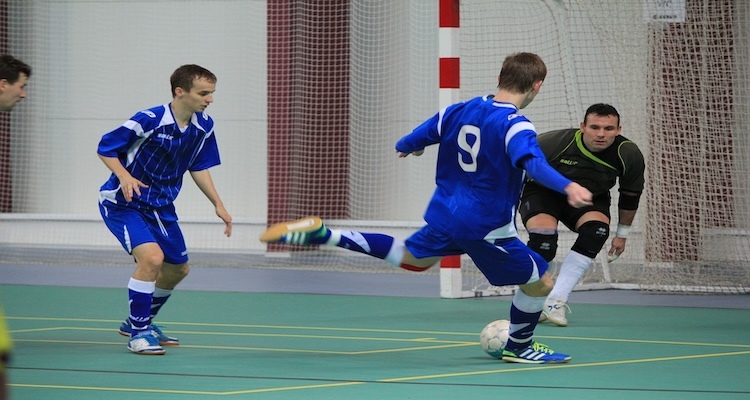
Futsal is a fast-paced and dynamic variant of football (soccer) which is typically played by individuals of various ages and skill levels. It's a sport that is popular among both amateurs and professionals. In many places, futsal is played by children and teenagers as part of organized youth leagues or as a recreational activity. Additionally, adults often participate in futsal leagues and tournaments for fun, fitness, and competition. Professional futsal players compete in national and international leagues, representing their clubs or national teams. Played on a smaller, hard court futsal demands agility, quick thinking, and technical prowess. However, like any sport, it carries inherent risks of injury. From sprains and strains to more severe conditions, understanding the most common injuries in futsal is crucial for players, coaches, and enthusiasts alike.
We now explore 10 of the most common injuries in futsal.
Ankle sprains are perhaps the most prevalent injury in futsal. The constant changes in direction, sudden stops, and sharp turns put immense strain on the ankles. When a player lands awkwardly or twists their ankle during a tackle or rapid movement, the ligaments can stretch or tear, leading to a sprain. These injuries can range from mild to severe and may require rest, rehabilitation, or even surgery in extreme cases.
The nature of futsal, with its quick accelerations, abrupt decelerations, and frequent pivoting, puts significant stress on the knees. Injuries such as anterior cruciate ligament (ACL) tears, meniscus tears, and patellar tendonitis are not uncommon. The sudden stops and changes in direction can cause the knee joint to twist unnaturally, leading to ligament or cartilage damage. Proper warm-up exercises, strengthening routines, and using supportive gear like knee braces can help reduce the risk of knee injuries.
Hamstring strains occur when the muscles at the back of the thigh are stretched beyond their limits or torn. In futsal, sprinting, sudden accelerations, and stretching to reach the ball can strain the hamstring muscles. Lack of proper warm-up, fatigue, and overuse can contribute to these injuries. Hamstring strains can range from mild discomfort to severe pain, requiring rest, ice, compression, and physical therapy for recovery.
Groin strains are common in sports that involve frequent kicking, twisting, and rapid changes in direction, making them prevalent in futsal. These injuries occur when the muscles of the inner thigh are overstretched or torn. Players may experience pain, weakness, or stiffness in the groin area, affecting their mobility and performance. Rest, gentle stretching, and strengthening exercises targeted at the groin muscles are essential for recovery and preventing recurrence.
The constant impact and contact with the ball and other players can lead to various foot and toe injuries in futsal. From stubbed toes and bruised feet to fractures and turf toe, players often endure these painful conditions. Proper footwear, including futsal-specific shoes with good grip and support, can mitigate the risk of foot injuries. Additionally, maintaining toenail hygiene and wearing protective gear like toe caps can help prevent trauma to the toes.
Muscles strains and sprains can occur in various parts of the body, including the calf, quadriceps, and lower back. Overexertion, sudden movements, and fatigue can predispose players to these injuries. Adequate warm-up, stretching, and conditioning exercises are crucial for preparing the muscles for the demands of futsal. Players should also listen to their bodies and avoid pushing through pain or fatigue, as it can increase the risk of strains and sprains.
While less common than other types of injuries, head injuries can still occur in futsal, particularly during collisions or falls. Concussions, skull fractures, and facial injuries are potential consequences of such incidents. Players should prioritize safety by using protective headgear, adhering to fair play rules, and practicing proper techniques to avoid dangerous collisions.
Overuse injuries result from repetitive motions and strain on specific body parts over time. In futsal, constant running, jumping, and kicking can lead to overuse injuries such as tendonitis, stress fractures, and shin splints. Proper rest, cross-training, and varying workout routines can help prevent overuse injuries and promote overall fitness and longevity in the sport.
Futsal is a high-impact sport, and players are susceptible to various injuries resulting from collisions with other players, the court, or the ball. Contusions, abrasions, and bone fractures can occur due to such impacts. Protective gear, such as shin guards, elbow pads, and ankle braces, can reduce the severity of these injuries and provide added safety on the court.
In indoor futsal facilities or during matches in hot climates, players are at risk of heat-related illnesses such as heat exhaustion and heatstroke. Dehydration, excessive sweating, and inadequate rest can exacerbate these conditions. Proper hydration, frequent breaks, and monitoring environmental conditions are essential for preventing heat-related illnesses and ensuring player safety.
In conclusion, while futsal offers an exhilarating experience for players and spectators alike, it's essential to recognize and address the risks of injuries associated with the sport. By understanding the most common injuries and implementing preventive measures such as proper warm-up, conditioning, and use of protective gear, players can enjoy the game safely and sustainably. Additionally, coaches and officials play a vital role in promoting a culture of safety and providing support for injured players to facilitate their recovery and return to play.
You should always consult a qualified healthcare professional about any injury prevention and/or injury management strategies. If you want to find a specialist to consult do search our easy to use directory to find a sports physiotherapist, chiropractor, sports therapist, or osteopath near you.
